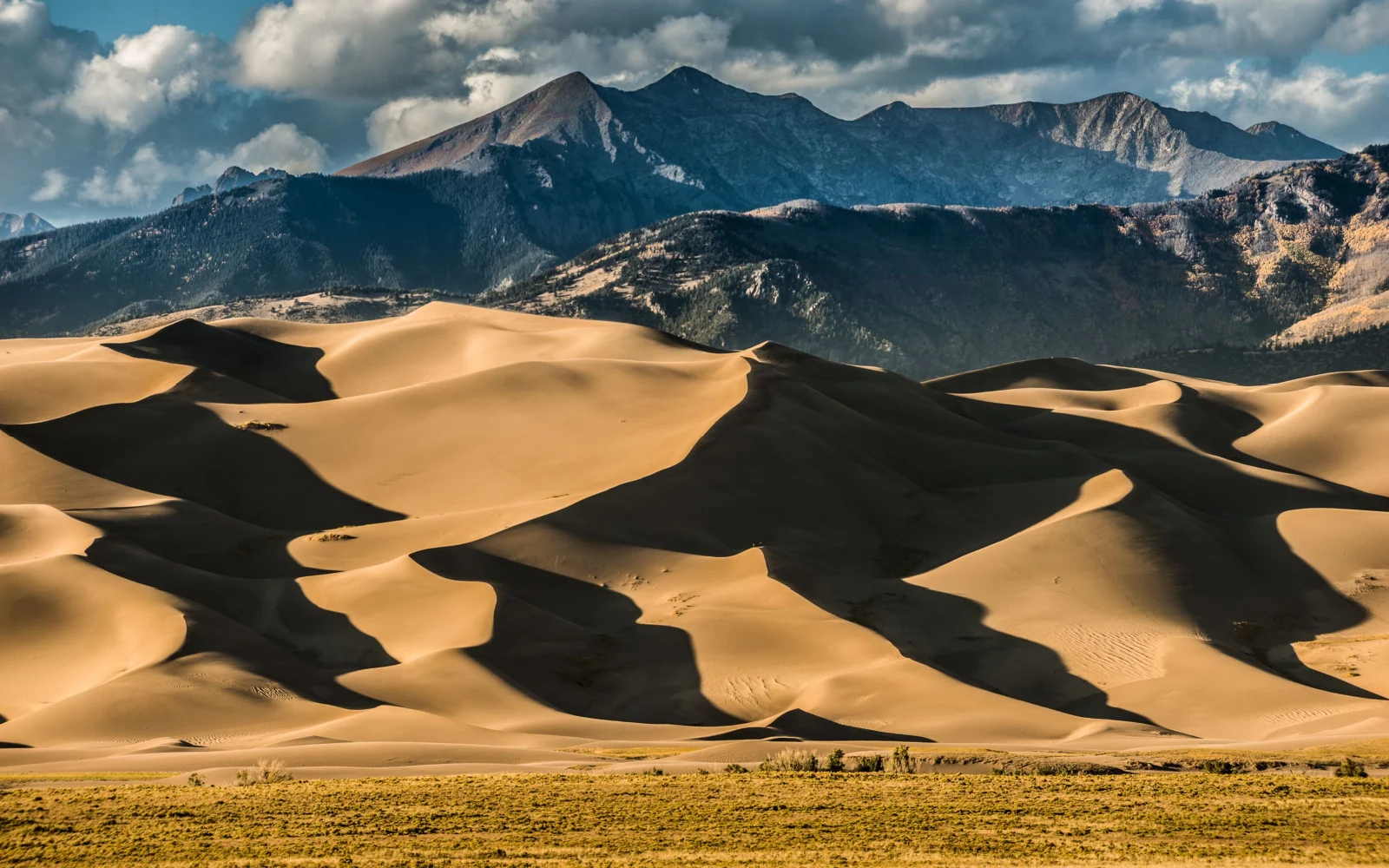What's the best time to visit Great Sand Dunes National Park?
The best time to visit Great Sand Dunes National Park is in late spring to early summer (May-June), when temperatures are moderate, making it ideal for dune exploration and experiencing Medano Creek’s unique surge flow. This period features comfortable camping conditions, educational ranger programs, and activities for kids. Due to its popularity, consider booking early and visiting on weekdays to avoid crowds.
Great Sand Dunes National Park in Colorado is unique among the state’s national parks. Instead of climbing tall mountains, you’ll be climbing sand dunes.
The main attractions are definitely the dunes, the tallest in North America, but the park also has a lot of other activities to offer. Go hiking near the rocky Zapata Falls, splashing in Medano Creek, or try out sandboarding.
Great Sand Dunes is a unique destination, even within the diverse National Park System. To make sure your experience is the best it can be, here is a quick guide to the best time to visit.
Overall Best Time to Visit Great Sand Dunes National Park
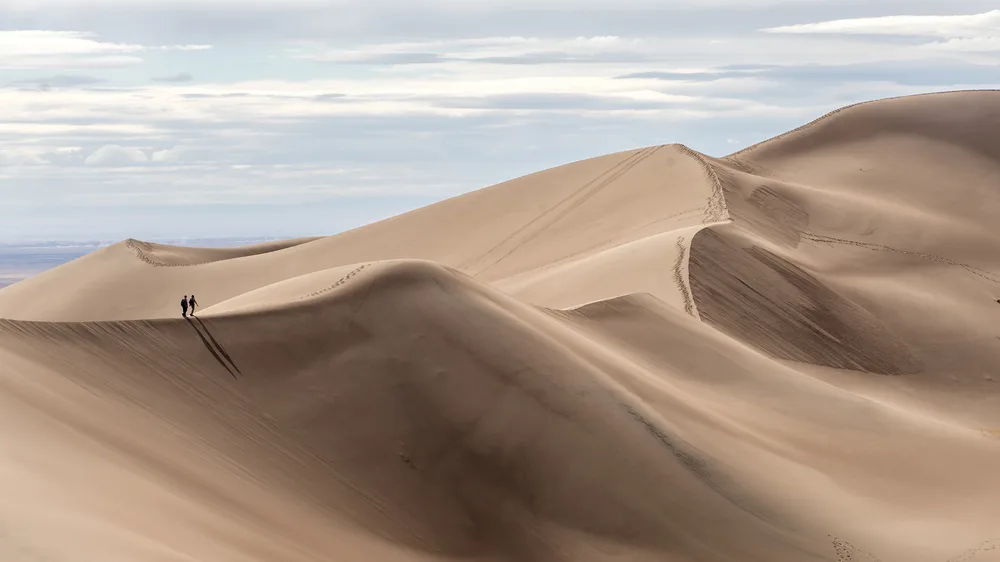
Andrew Repp/Shutterstock
The best time to visit Great Sand Dunes National Park is in late spring and early summer (May-June), when you can get the best experience frolicking on the dunes.
One reason why this is the best time to visit is that the weather is best for exploring. Winter and early spring are volatile, with cold nighttime temperatures and snowstorms well into April.
On the other hand, the summer is very hot, especially on top of the sand dunes. May and June offer a sweet spot in terms of temperatures. Temperatures are generally not too hot, with daytime averages in May at about 75 degrees Fahrenheit.
Temperatures drop drastically at night, but it’s warm enough to camp comfortably. In the middle of the day, the sand dunes can get hot, but you can hike them comfortably in the morning.
The biggest reason to visit in May and June is to experience Medano Creek. This stream in the dunes is created by “surge flow,” or water flowing over sand.
The unique rolling waters are a popular destination for families, who come to wade, splash, and go tubing down the creek. Since Medano Creek is formed by surge flow, it is only full of water seasonally, when snowmelt from the top of the dunes flows to lower elevations.
May and June are the best months to visit to experience this creek. The creek is still visible in early July, but water levels are very low.
The National Park Service website offers an explanation of how the creek works as well as annual flow predictions. During this time, the park is starting to come alive. All campgrounds are open by May. Ranger programming starts up on April weekends and is offered full-time by May.
Guided hikes and talks can help you understand the context behind the sand dunes, and kids will love participating in the Junior Ranger program.
Just keep in mind that May and June are the most popular months to visit the park, and crowds continue into early July. Try to visit on a weekday if you can as weekend traffic jams are fairly unbearable.
Cheapest Time to Visit Great Sand Dunes National Park
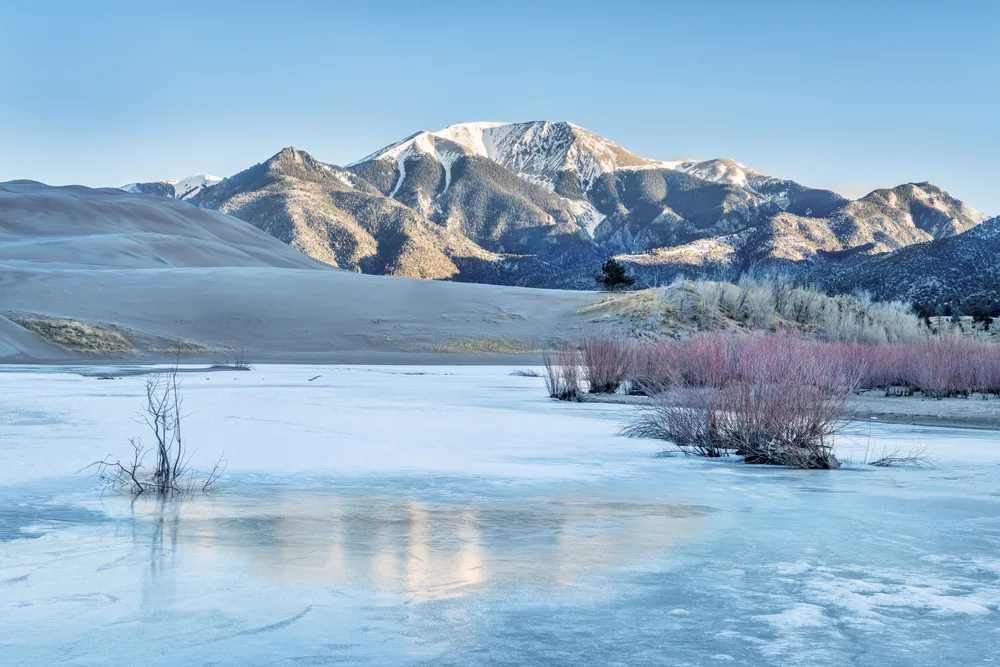
Marekuliasz/Shutterstock
The cheapest time to visit Great Sand Dunes National Park is in the winter (November-March) but you can also find deals into April, or early spring.
Winter doesn’t get a lot of visitors because of the weather. Temperatures are bitterly cold, with average highs in the teens in January. The cold weather lasts into early spring—April is actually the second-snowiest month.
Early spring (March and April) are warmer than winter, but the weather is worse due to its unpredictability. Storms are common, as are gale-force winds, which make standing on top of a sand dune an unpleasant experience.
Since there is much lower demand, hotel room prices also go down. There are no hotels within the park itself, but you can find good deals in the nearby town of Alamosa.
In the winter, nearly all hotels offer at least 20% discounts compared to peak season prices. Visit in November and you can get low-season discounts, but still have some open trails. The discounts on hotels continue well into spring, with March and April also having lower prices.
In April, the Piñon Flats Campground opens again to visitors, which is the most affordable accommodation option of all. The least expensive time to visit the park is the early spring.
The two least expensive months to fly to Denver International Airport, the closest major airport, are January and April (by April, ski season is over, so demand is lower). During the spring shoulder season, you can also negotiate better deals on car rentals from Denver.
Least Busy Time to Visit Great Sand Dunes National Park
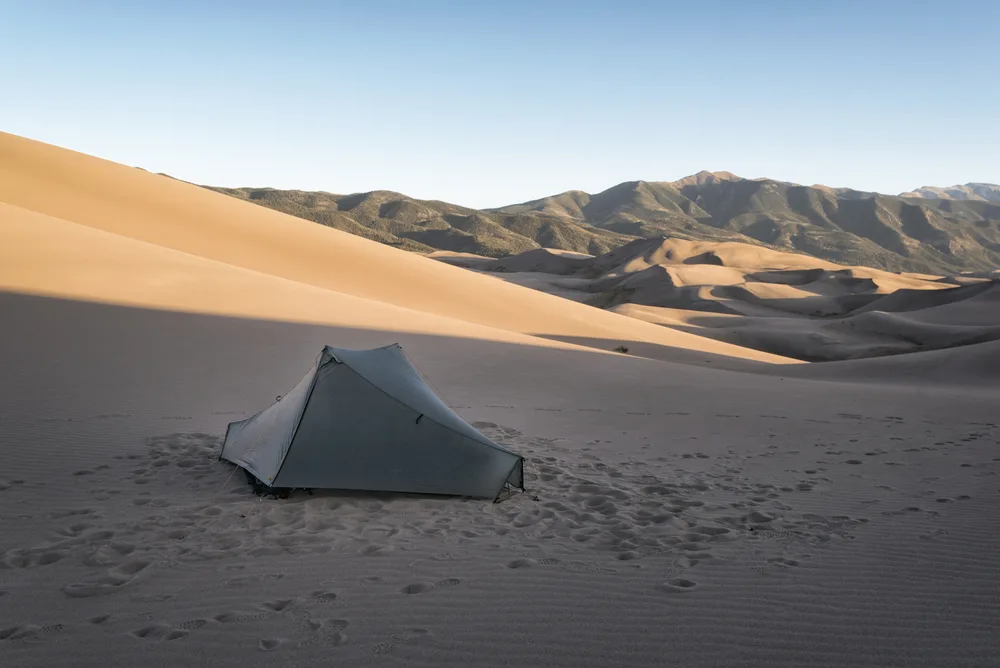
Patrick Lienin/Shutterstock
The least busy time to it Great Sand Dunes is in the fall (September-October) to experience the park without many crowds. As soon as September rolls around and kids head back to school, the crowd levels in the park drop drastically.
You won’t have to wait too long to buy your ticket or find a parking spot. The most popular viewpoints are also less crowded, making it easier to spot wildlife such as pronghorn, who get scared away by massive crowds in the summer.
The weather is also much better during the fall. Temperatures are already cooling down by September, and crisp and cool in October. Daily average temperatures are 60-70 degrees Fahrenheit, although by early October nighttime temperatures are below freezing.
By mid-October, you can even see some early season snow. The milder temperatures make it far easier to explore the park. You can hike the mountain trails and see the aspens change color.
This is also better weather to hike the sand dunes because the sand is no longer burning hot. Plus, you’ll get to see the true majesty of the dune landscape better when it’s not crawling with people.
Worst Time to Visit Great Sand Dunes National Park
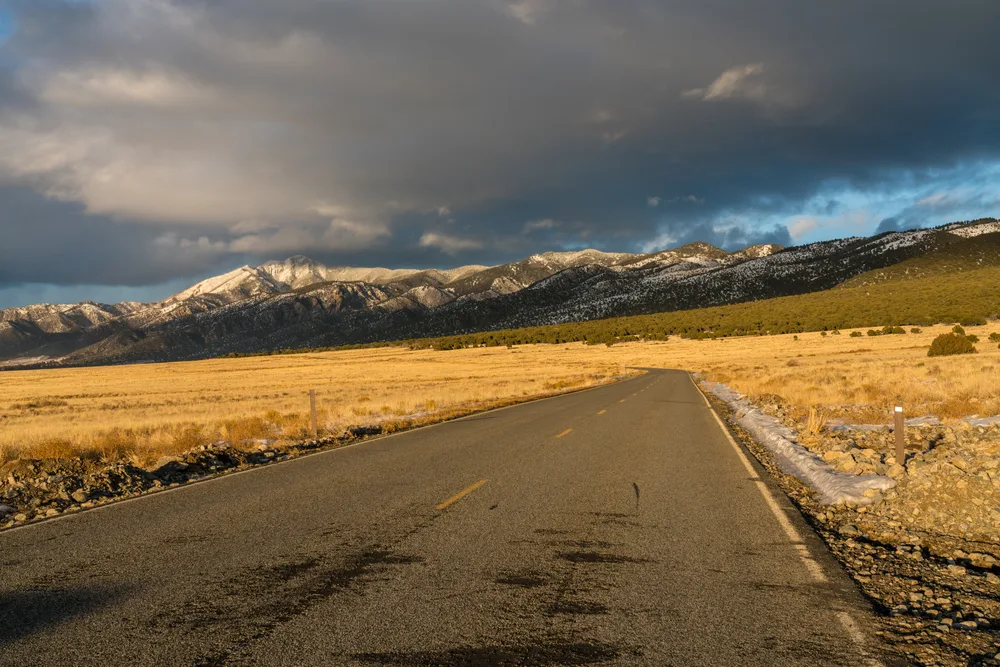
Brian Wolski/Shutterstock
The worst time to visit Great Sand Dunes National Park is during the peak of summer (July-August) when hot conditions make it difficult to explore the sand dunes properly.
Great Sand Dunes National Park has an extreme climate. After very cold winters, the summers are very hot. Surface temperatures are often around 85 degrees Fahrenheit at the park, but usually feel much hotter.
There is no shade on the dunes, and the sun can get as hot as 150 degrees Fahrenheit. There are other problems associated with visiting Great Sand Dunes National Park in the summer.
This is the rainiest season in the park, and frequent thunderstorms are downright dangerous, especially since people are vulnerable to lightning strikes on top of the dunes.
During the summer, the mosquitoes and no-see-ums are also out in full force, making camping uncomfortable. Summer is also the most crowded time to visit the park, so expect long lines, crowded parking lots, and campgrounds that fill up quickly if you don’t reserve far enough in advance.
There’s still a way to make your visit in the summer pleasant. Visit earlier in the day or in August, which is cooler and has fewer bugs.
Great Sand Dunes National Park by Month
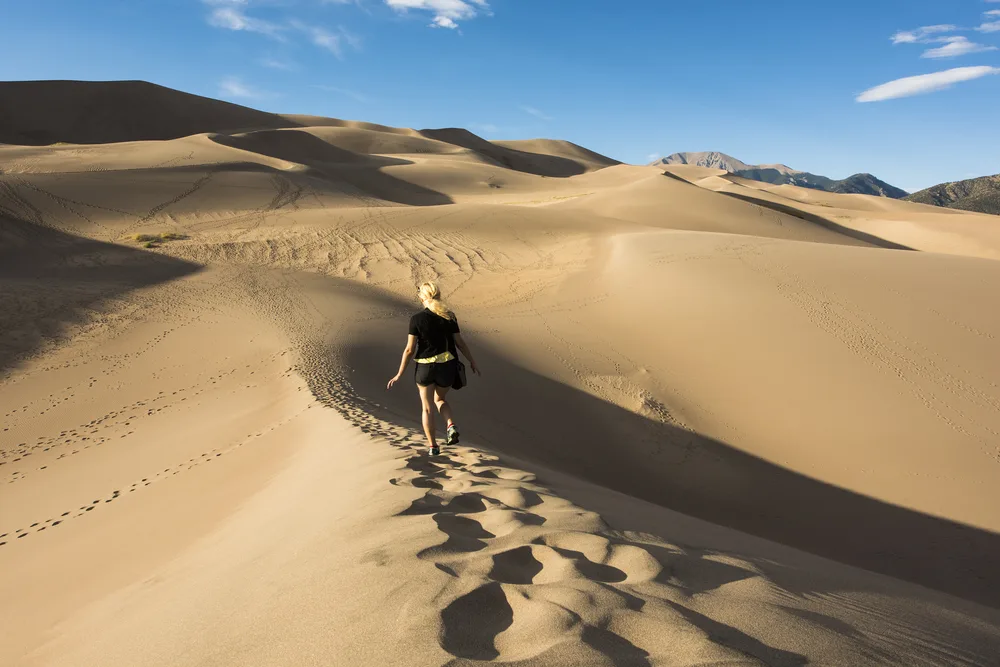
Andriy Blokhin/Shutterstock
Still unsure about the best time to visit Great Sand Dunes National Park? Take a look at our summary of the weather and climate by month below:
January
January in Great Sand Dunes National Park, with temperatures often between 8 to 34°F (-13 to 1°C), presents a serene winter landscape. It’s perfect for snowshoeing on the dunes, capturing stunning winter photography, and enjoying the peacefulness of the park in its off-season.
February
February continues the winter charm, ideal for sledding down the snow-covered dunes, exploring the frozen Medano Creek, and stargazing under the crisp winter skies, often clear and perfect for astronomy enthusiasts.
March
As the snow begins to melt in March, temperatures range from 16 to 46°F (-9 to 8°C). This is a great time for early spring hikes, watching the unique phenomenon of “sand-surfing” down the dunes, and spotting the early wildlife awakening in the park.
April
April’s milder weather, with temperatures between 22 to 55°F (-6 to 13°C), beckons for sandboarding and sand sledding on the dunes, enjoying the stunning sunsets over the Sangre de Cristo Mountains, and exploring the park’s diverse ecosystems.
May
May brings warmer days, from 34 to 67°F (1 to 19°C), perfect for hiking the park’s trails, such as the challenging High Dune trail, exploring the Medano Pass Primitive Road for off-road adventure, and enjoying the night skies during the new moon.
June
June, welcoming summer with temperatures between 42 to 79°F (6 to 26°C), offers ideal conditions for camping under the stars, experiencing the Medano Creek as it swells with spring runoff, and attending ranger-led programs to learn about the park’s unique geology and ecology.
July
July’s warmth, with temperatures from 50 to 83°F (10 to 28°C), is all about splashing in the Medano Creek, enjoying picnics with stunning dune views, and exploring the surrounding hiking trails like Mosca Pass.
August
In August, with temperatures of 49 to 80°F (9 to 27°C), explore the Zapata Falls, just outside the park, enjoy early morning hikes to beat the summer heat, and witness the diverse birdlife in the park’s wetlands and grasslands.
September
Welcoming fall, September, with temperatures from 42 to 73°F (6 to 23°C), is perfect for experiencing the changing colors in the surrounding mountains, enjoying quieter visits after the summer crowds, and stargazing during the clear, cool nights.
October
October’s cooler days, from 28 to 62°F (-2 to 17°C), are ideal for exploring the park without the extreme heat of summer, photographing the dunes against the backdrop of autumn foliage, and enjoying wildlife viewing, as many animals are more active in the cooler temperatures.
November
November, as the air turns brisk, temperatures from 17 to 49°F (-8 to 9°C), is a time for peaceful walks on the dunes, capturing the early snowfalls on camera, and enjoying the solitude of the park before the winter sets in.
December
December brings a quiet winter landscape, with temperatures ranging from 8 to 35°F (-13 to 2°C). This month is perfect for winter hiking, enjoying the unique beauty of the snow-covered dunes, and celebrating the holiday season in the tranquility of nature.
Frequently Asked Questions
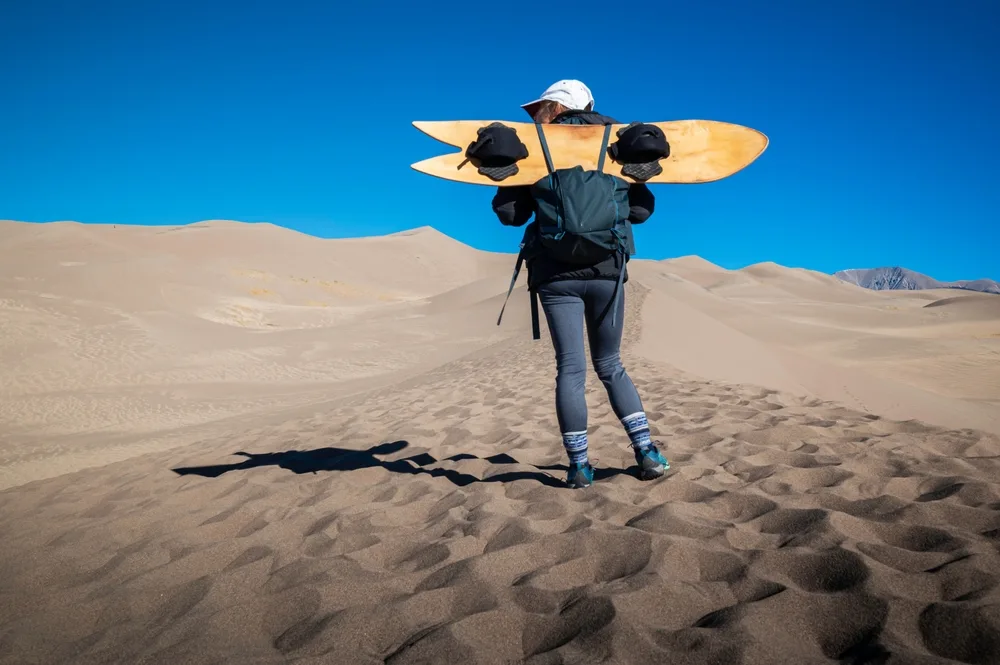
David Spates/Shutterstock
Here are a few of the most common questions people have asked about visiting the park:
How many days do you need in Great Sand Dunes National Park?
You need at least two days in Great Sand Dunes National Park to explore the dunes and the hiking area. You want to stay after dark at least once to see the stars.
Is Great Sand Dunes worth it?
Great Sand Dunes is worth it if you want to see this unique geological phenomenon. However, if you have limited time in Colorado, it’s better to pick another park.
Can you enter Great Sand Dunes at any time?
Yes, you can enter Great Sand Dunes National Park at any time. There are no limits or timed reservations.
Do you need a 4WD for Great Sand Dunes National Park?
If you want to drive the main scenic road in Great Sand Dunes National Park, Medano Pass Primitive Road, you need a high-clearance 4WD. However, you can see most of the park on foot.
How long do people spend at Great Sand Dunes?
Most people spend just a few hours at Great Sand Dunes since it’s a popular day trip for local families. However, hikers spend a day or two.
So, What’s the Best Time to Visit Great Sand Dunes National Park?
For the best Great Sand Dunes experience, visit in May or June. That is when you can go sandboarding, explore the dunes, and splash in the creek. For fewer crowds and lower prices, visit in fall, winter, or early spring.
So, with so much to see and to and plenty of amazing times to visit, what are you waiting for — book your trip today and experience for yourself all that the park has to offer. Happy travels!



